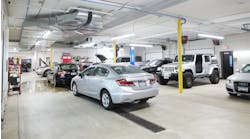Six years ago, Diania Ringer became shop manager of Interstate Ford Collision Center at a time when the shop had only four employees and considered $18,000 in labor to be a good month, especially since the collision center didn’t have DRPs.
Instead of being satisfied with slow-and-steady growth, Ringer implemented large changes that brought huge results. Not only did she sign with eight DRPs over the past few years, she’s more than doubled the per-month revenue, and at the shop’s current growth rate, she’s likely to triple that original number before long.
The 14-bay, 6,500-square-foot shop in Miamisburg, Ohio, now brings in about $500,000 in annual revenue, employs 15 people and sees 120 cars every month.
The changes have come largely as a result of Ringer’s commitment and focus. “When I came here as the manager, I had to prove myself, my work ethic, how the team was going to flow and what kind of work we could do for the insurance companies to be able to go [after] those DRPs,” she says.
—Diania Ringer, manager, interstate ford collision center
Other shops could learn from the kind of straightforward strategies that Ringer put into place. Here follows a glimpse of her recipe for success.
Hire based on revenue goals, not current needs
There are two ways to approach hiring: Either a shop will bring in more employees as the business grows, or a manager will hire first and expect business to follow. Although the second approach seems like the riskier tactic, it’s been a major part of the collision center’s success at Interstate Ford.
“The more techs you have, the more money you make,” says Ringer. “That might sound simplistic, but that’s what worked for us.” When she started, the shop had three techs and a painter, with one of the techs acting as an assistant manager. She immediately began searching for additional employees and hiring those who could deliver high-quality results on schedule.
“Hire the techs first, then bring the work in,” she advises. “You can schedule more that way, rather than scheduling far out. If a customer calls, I don’t want to tell them I can take them in a week, much less a couple weeks. My philosophy is to always be at a point where I say, ’How soon can you get here? I can take you right now.’ For that, you need the techs.”
Keep the training going, along with the praise
Another top strategy at Ringer’s collision center is to encourage technicians to participate in certification programs. She employs several who are one class away from I-CAR platinum status, and others are learning about 3M sealers and SEM sealers, for instance.
Ongoing training comes with many advantages: Insurance companies are assured of technician skill, techs learn the latest techniques and knowledge becomes a form of employee retention.
“When techs know that we care about their certification, they feel like they’re being taken care of,” says Ringer. “The key to keeping your people is letting them know you appreciate them. Offering these opportunities for more education is part of that.”
Also part of that strategy is the art of saying “thank you,” adds Ringer. She says that phrase constantly, and she means it. She lets techs know that without them, there wouldn’t be DRPs or customers or even a shop. When there’s a major boost to the shop’s profile or bottom line—like the inclusion of another DRP—Ringer congratulates all the employees. Her efforts to acknowledge the team haven't gone unnoticed.
"She leads with a disciplined approach and makes sure to share the credit and success of the operations with her team," says Chuck George, owner of Interstate Ford.
Make customers comfortable and DRPs will follow
Every shop claims to pay close attention to customer service, but Ringer makes sure that she backs up that assertion with real action.
“Take time to write the estimate, even if you’re not in a program with their insurance company,” she advises. “If I tell people to go to their insurance adjuster to get the estimate, what I’m really saying is, ‘I don’t have time for you.’ Instead, you should treat every person like they’re your only customer.”
Ringer prefers a gentle approach in which she listens closely to what customers need. She emphasizes that people walk into the shop already unhappy about an accident or problem, and being able to explain the process to them goes a long way toward alleviating their anxieties.
“They’re already devastated by what’s happened,” she says. “If I make them comfortable and take time to walk them through a process, they remember that. I say that we repair cars, but we also repair people’s egos and broken hearts.”
The other major advantage to exemplary, above-and-beyond service is that customers will talk to their insurance companies, and with enough positive feedback, that translates to DRPs.
Ringer didn’t actively pursue DRPs, she notes; it was only through better customer service that the insurance firms came to the collision center. “You don’t say, ‘I think I’m going to get on this DRP,’” she says. “You wait for insurance companies to invite you. And they do that when you turn out a quality product in a timely manner in a way that keeps customer satisfaction high.”
Keep customers happy, she believes, and the insurance firms will be happy, too. That creates a chain reaction in which one DRP will lead to another. Ringer points out that insurance adjusters may not hang out together, but they do tend to end up at the same shops frequently, and like anyone else in the business, they like to swap stories. A reputation for honesty, customer service, and high-level work will circulate just as much as negative impressions.
Use waterborne paint as a profit driver
Under Ringer’s leadership, the collision center became one of the first in the Dayton area to convert to waterborne paint.
Much like her forward-thinking strategies with hiring, Ringer believes that this is a major direction in the industry, and she didn’t want to be playing catch-up. More importantly, she saw the shift more as a profit driver than a major expenditure.
“When customers find out that you’re a green shop, they like coming even more,” she says. “We don’t have fumes, it’s healthier for everyone, and I think it’s positively affected the business.”
Although the switch required an initial investment, Ringer notes that painters don’t need to use as much product, and labor time was saved because of faster drying times. Also, booths didn’t need to be as hot, which lowered temperature control costs. She says, “This is a classic example of how you have to spend money to make money.”
Ringer has come a long way since her start in the industry—hanging out with her dad, who ran two gas stations and was always tinkering in the garage—and she’s eager to keep moving forward for her collision center.
“I have two great passions in life,” she says, “my grandkids and this shop.” Given Ringer’s straightforward, strategic recipe for growth and her investment in the shop, her future success seems as certain as her current passions.



